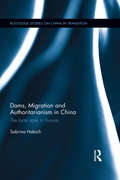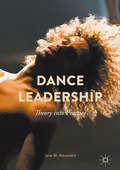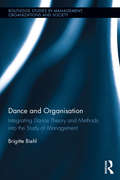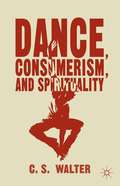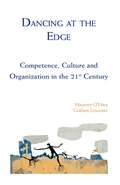- Table View
- List View
Dams in Brazil: Social and Demographical Impacts (SpringerBriefs in Latin American Studies)
by Guillaume LeturcqThe book focuses on the human and social effects of the construction of hydroelectric dams in Brazil. It discusses themes such as forced migrations, how the families of the victims of the dams adapt to new living areas, the struggle of families with the relocation of their homes and the fact that they are neglected by builders and government. These discussions are carried out in a comparative perspective between Southern and Northern Brazil, where contexts and living conditions are quite different. The book's main objective is to analyze the movements, adaptations and life changes in families suffering from the effects of dams throughout Brazil. This is the first book that analyzes the relationship dam-space with the intent to understand how dams affect the territory. The book is organized in three chapters: the dams’ effects in Brazil and the territorial impacts; human and social consequences of dam construction; a regional comparison of the effects of dams between the South and the North of the country.
Dams, Migration and Authoritarianism in China: The Local State in Yunnan (Routledge Studies on China in Transition)
by Sabrina HabichPast studies on the Chinese state point towards the inherent adaptability, effectiveness and overall stability of authoritarian rule in China. The key question addressed here is how this adaptive capacity plays out at the local level in China, clarifying the extent to which local state actors are able to shape local processes of policy implementation. This book studies the evolution of dam-induced resettlement policy in China, based on extensive fieldwork conducted in Yunnan province. It shows that local governments at the lowest administrative levels are caught in a double bind, facing strong top-down pressures in the important policy field of hydropower development, while simultaneously having to handle growing social pressure from local communities affected by resettlement policies. In doing so, the book questions the widespread assumption that the observed longevity and resilience of China’s authoritarian regime is to a large extent due to the high degree of flexibility that has been granted to local governments in the course of the reform period. The research extends beyond previous analyses of policy implementation by focusing on the state, on society and the ways in which they interact, as well as by examining what happens when policy implementation is interrupted. Analysing the application of resettlement policies in contemporary China, with a focus on the multiple constraints that Chinese local states face, this book will be of interest to students and scholars of Political Science, Chinese Studies and Sociology.
Dan Gordon
by Michael J. RobertsDescribes Dan Gordon's first month on the job as Chief Operating Officer of Club Sports International (CSI), a chain of 7 health and fitness clubs. Describes the company's strategy and organization. The company needs Dan to tighten up its operations and create a base that will permit CSI to grow to 30 clubs. Describes virtually no systems, controls, or mechanisms that are in place to actually manage the business. Thus students must paint this blank canvas with their view of the systems needed to manage the business, and what Dan must do to make it work.
Dan Stewart (A)
by Mark Rhodes Vijay V. SatheA subordinate who Dan Stewart has recently placed on warning for unsatisfactory performance is suddenly appointed Dan's boss. Involves such issues as the management of disappointment, understanding organizational irrationality, lateral transfer within the same company, and dealing with organizational politics.
Dan Stewart (C)
by Mark Rhodes Vijay V. SatheDan is given an assignment as general manager of a small division with some difficulties but exciting possibilities. How should he manage the situation?
Dana Hall: Excerpts from a Letter from Head of School Caroline Erisman, May 2015
by F. Warren McfarlanDana Hall is a private all-girls school in New England facing a crisis in its mission. As social norms shift away from single-sex education, the school's enrollment is falling and deficits are becoming the norm. At the same time, the modern vision for girls' education requires an even greater investment in science and sports--at a time when Dana Hall's resources are lower than ever before. Can the school stay true to its mission? How will it find the funding? Through the story of Blair Jenkins, head of school, this case examines the difficult mission and funding decisions facing many nonprofit organizations.
Dana Hall: Funding a Mission (A)
by F. Warren Mcfarlan Herman B. Leonard Melissa TritterDana Hall is a private all-girls school in New England facing a crisis in its mission. As social norms shift away from single-sex education, the school's enrollment is falling and deficits are becoming the norm. At the same time, the modern vision for girls' education requires an even greater investment in science and sports--at a time when Dana Hall's resources are lower than ever before. Can the school stay true to its mission? How will it find the funding? Through the story of Blair Jenkins, head of school, this case examines the difficult mission and funding decisions facing many nonprofit organizations.
Dana Hall: Funding a Mission (B)
by F. Warren Mcfarlan Herman B. Leonard Melissa TritterSupplements the (A) case.
Dana Hall: Funding a Mission (C)
by F. Warren Mcfarlan Herman B. Leonard Melissa TritterAn abstract is not available for this product.
Dana Hall: Funding a Mission (D)
by F. Warren Mcfarlan Kaitlyn SzydlowskiThis case is a sequel to Dana Hall: Funding a Mission (A), (B) and (C) cases. It focuses on the causes of recent fund-raising success and the complex resource allocation problems the School faces as it tries to deliver on its mission. In conjunction with the (A), (B) & (C) cases, it is a rich story of how mission and finance can play out over a very long period.
Dana-Farber Cancer Institute
by Richard Bohmer Ann B. WinslowDescribes the death of a cancer patient in one of the nation's premier cancer treatment centers and examines the organizational and process characteristics that may have contributed to the medical error.
Dana-Farber Cancer Institute: Development Strategy
by V. Kasturi Rangan Marie BellDespite revenues in excess of $93 million in 1998, world-renowned Dana-Farber Cancer Institute constantly faces an operating shortfall and looks to its highly successful development office to help cover the deficit. The development office raises money annually (with a $42 million goal for 1999) through its two major fund-raising arms: the Development Fund and the Jimmy Fund. In addition, it conducts a major capital campaign about every five years. A new chief development officer, Susan Paresky, needs to establish the development strategy going forward. The case reviews the major fund-raising programs in the development office and presents additional growth options. Students examine the existing programs, assess the value of the new options, and devise a development strategy consistent with the mission and philosophy of the institute.
Danaher Corporation
by Bharat N. Anand David J. Collis Sophie HoodBetween 1985 and 2007, Danaher has been one of the best-performing industrial conglomerates in the U.S. This case examines the corporate strategy of this diversified, global corporation. It describes the firm's portfolio strategy and the Danaher Business System-a systematic and wide-ranging set of organizational processes the firm has developed to drive growth and create value. In 2008, the firm confronts various challenges in sustaining its impressive historical performance. First, can it continue to balance organic and acquisition-led growth? Second, what will be the impact of increased competition from private equity players? Third, for how long can its strategy of "continuous improvement" continue?
Danaher Corporation (Abridged)
by Bharat N. Anand David J. Collis Sophie HoodBetween 1985 and 2007, Danaher has been one of the best-performing industrial conglomerates in the U.S. This case examines the corporate strategy of this diversified, global corporation. It describes the firm's portfolio strategy and the Danaher Business System-a systematic and wide-ranging set of organizational processes the firm has developed to drive growth and create value. In 2008, the firm confronts various challenges in sustaining its impressive historical performance. First, can it continue to balance organic and acquisition-led growth? Second, what will be the impact of increased competition from private equity players? Third, for how long can its strategy of "continuous improvement" continue?
Danaher Corporation, 2007-2017
by John R. Wells Gabriel EllsworthOn July 2, 2016, Danaher Corporation completed the spinoff of Fortive Corporation. The previous day, Danaher's stock price had reached an all-time high. In 2015, Danaher had decided to split off its test and measurement, fuel and fleet management, and automation businesses, leaving the "new Danaher" focused on life sciences, diagnostics, dental, water quality, and product-identification businesses. It was hardly the first industrial conglomerate to spin off major divisions; Tyco International PLC, ITT Corporation, Illinois Tool Works, Johnson Controls, and Ingersoll-Rand PLC had made similar moves in recent memory. However, its peers had often experienced declining profitability or pressure from activist investors. Danaher, by contrast, had performed strongly in the years leading up to the spinoff. It had spent the previous decade strengthening its portfolio in sectors such as life sciences and dental products with acquisitions including Beckman Coulter in 2011, Nobel Biocare Holding AG in 2014, and Pall Corporation in 2015.
Dance Leadership: Theory Into Practice
by Jane M. AlexandreThis "what is"--rather than "how to"-- volume proposes a theoretical framework for understanding dance leadership for dancers, leaders, and students of both domains, illustrated by portraits of leaders in action in India, South Africa, UK, US, Brazil and Canada. What is dance leadership? Who practices it, in what setting, and why? Through performance, choreography, teaching, writing, organizing and directing, the dance leaders portrayed herein instigate change and forward movement. Illustrating all that is unique about leading in dance, and by extension the other arts, readers can engage with such wide-ranging issues as: Does the practice of leading require followers? How does one individual's dance movement act on others in a group? What does 'social engagement' mean for artists? Is the pursuit of art and culture a human right?
Dance and Organization: Integrating Dance Theory and Methods into the Study of Management (Routledge Studies in Management, Organizations and Society)
by Brigitte BiehlDance and Organisation is the first comprehensive work to integrate dance theory and methods into the study of management, which have developed an interest in the arts and the humanities. Dance represents dynamics and change and puts the moving body at the centre, which has been ignored and oppressed by traditional management theory. ‘Being’ a leader however also means to ‘move’ like one, and critical lessons can be learned from ballerinas and modern dancers. Leadership is a dialogue, as in the work of musicians, conductors and DJs who manage groups without words. Movement in organisational space, in a museum or a techno club can be understood as a choreography and site-specific performance. Movement also is practically used for leadership and employee development workshops and can be deployed as an organisational research method. By taking a firm interdisciplinary stance in dance studies and organisational research to explore management topics, reflecting on practitioner accounts and research projects, the book seeks to make an innovative contribution to our understanding of the moving body, generating new insights on teamwork, leadership, gender in management, organisational space, training and research methods. It comprises an important contribution to the organizational behaviour and critical management studies disciplines, and looks to push the boundaries of the academic literature.
Dance of Disruption and Creation: Epochal Change and the Opportunity for Enterprise
by Nandu Nandkishore Neeraj ChandraIt’s an exciting time to be alive! We are witness to an epoch of change, a dance of disruption and creation, that is re-imagining our world. Where are these disruptions coming from? What opportunities do they uncover? How can one make sense of them? And most importantly, how should one prepare and act? This book, written by two influential business leaders, unpacks these "epochal" changes and how they represent a defining moment of opportunity for the world of business. Nandu Nandkishore and Neeraj Chandra draw upon diverse sources, academic literature, discussions with CEOs, startup founders and experts, in order to understand the significant pivots of change emerging from a wide canvas and then stitch together a perspective of an exciting, brave new world. Unlike many other books that focus only on emerging technologies, the authors here look at disruption through several lenses: technology, demographics, economic change, the changing nature of institutions, and the interplay of technology as it fundamentally shapes consumers and society. The book goes beyond describing changes taking place. It explores the "why so" and "so what" to provide an understanding of the shifts taking place, and crucially, the implications for the world of enterprise. Using simple examples and frameworks throughout, the book provides specific, action-oriented solutions that businesses can employ. This book will be of specific interest to business leaders, strategists, investment professionals, as well as social scientists and public servants. It is for change-makers who are excited to seize the unique opportunity that this change represents – to build competitive advantage, re-invent markets and enterprise, and indeed, to make the world a better place. A selection of reference links and material for the book is accessible at www.routledge.com/9781032184791.
Dance, Consumerism, and Spirituality
by C. S. WalterDance has proliferated in movies, television, Internet, and retail spaces while the spiritual power of dance has also been linked with mass consumption. Walter marries the cultural studies of dance and the religious aspects of dance in an exploration of consumption rituals, including rituals of being persuaded to buy products that include dance.
Dances with Dependency: Out of Poverty Through Self-Reliance
by Calvin HelinDances with Dependency offers effective strategies to eliminate welfare dependency and help eradicate poverty among indigenous populations. Beginning with an impassioned and insightful portrait of today&’s native communities, it connects the prevailing impoverishment and despair directly to a &“dependency mindset&” forged by welfare economics. To reframe this debilitating mindset, it advocates policy reform in conjunction with a return to native peoples&’ ten-thousand-year tradition of self-reliance based on personal responsibility and cultural awareness. Author Calvin Helin, un-tethered to agendas of political correctness or partisan politics, describes the mounting crisis as an impending demographic tsunami threatening both the United States and Canada. In the United States, where government entitlement programs for diverse ethnic minorities coexist with an already huge national debt, he shows how prosperity is obviously at stake. This looming demographic tidal wave viewed constructively, however, can become an opportunity for reform—among not only indigenous peoples of North America but any impoverished population struggling with dependency in inner cities, developing nations, and post-totalitarian countries.
Dancing At The Edge: Competence, Culture And Organization In The 21st Century
by Maureen O'Hara Jennifer Williams Graham LeicesterIn his 1980 essay, The World of Tomorrow and the Person of Tomorrow, the psychologist Carl Rogers contemplated the future. He described those who would usher in this new era as people with the capacity to understand, bring about and absorb a paradigm shift. He added: "I have an uneasy feeling about this chapter... It is a beginning, an outline, a suggestion... I believe that what I am saying here will some day be fleshed out much more fully, either by me or someone else." Maureen O'Hara and Graham Leicester are uniquely qualified fleshers-out. They draw on their own extensive research and practical experience observing some of today's most successful cultural, political and business leaders to explore the competencies that can best help us navigate the 'blooming, buzzing confusion' of the 21st century. They conclude that these are innate and within reach of all of us - given the right setting, plenty of practice and some gentle guidance. But they are seldom seen because they are routinely undervalued in today's culture. That must change, the authors insist, and this book is intended to begin that change. Theodore Hesburgh, President Emeritus of Notre Dame University, once said that leadership demands certainty: "You cannot blow an uncertain trumpet." On the contrary, argue Leicester and O'Hara, we must all learn to play the uncertain trumpet like virtuosos. It is an image that conveys the subtle discipline required of 'persons of tomorrow.' "They are the people already among us who inhabit the complex and messy problems of the 21st century in a more expansive way than their colleagues... They dance at the edge."

